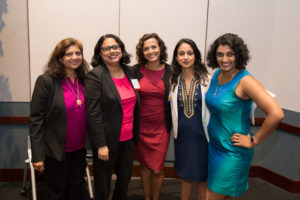
Impact Project Board Member Mini Timmaraju with (L to R) candidates Padma Kuppa, herself, Hiral Tipirneni, Dita Bhargava, and Megan Srinivas (Photo courtesy: IAIMPACT)
Twenty two years ago, in 1995, when Raj Goyle was just 20, he became an intern at the Democratic National Committee. There were virtually no Desi faces around, he remembers. Years later, Goyle got elected to the Kansas state legislature, for two terms, in a
Republican leaning district. But 1995 was a signal year in many ways as it came after a long dry spell from 1957, when a determined Dalip Singh Saund, broke all barriers to become a Congressman from California. The mid-1990s saw Kumar Barve get elected delegate in the Maryland General Assembly later becoming House Majority Leader. He is still there, one of very few if any, who were successful in the year that the Bill Clinton wave was sweeping America, and a slew of Indian-American candidates ran on his coat-tails. Ram Uppuluri, Neil Dhillon, come to mind. Soon after however, Satveer Chaudhary got elected to the Minnesota House and later the state Senate. serving from 1996 to 2010. In 2003, Swati Dandekar was elected to the Iowa state assembly, and later to the state senate.
The 1990s were also the years when some Indian-Americans took to learning the craft behind government, breaking the stereotype of doctor, engineer, scientist, etc. The mid-1990s onwards was the time when a germ was planted of the need to help aspiring Indian-American candidates run and win in campaigns. But it was not an organized effort with an infrastructure to push it along. The Washington Leadership Program was launched by publisher Gopal Raju in 1996, placing Indian-American youth in Congressional offices. The Indian American Leadership Initiative took off. Meanwhile, there were Indian-Americans around the country making individual efforts to get elected to school boards, city councils, etc.
Today, WLP continues in the hands of alumni like Harin Contractor, has expanded and is supported by publisher of U.S.-India Global Review, Padma Shri Dr. Sudhir Parikh, who took over the mantle from Raju.
Fast forward to 2016 — five Indian-Americans are in Congress, after the Obama wave, and a host of candidates (80 by some counts) are running up and down the ballot (see iaimpact.org). As of July 2018, five Indian Americans serve in the United States Congress: Senator Kamala Harris, D-California; and Representatives Ami Bera, D-California, Pramila Jayapal, D-Washington, Ro Khanna, D-California, and Raja Krishnamoorthi, D-Illinois. Those in the House are in the throes of campaigning for re-election come Nov. 6. Of the 16 Asian-American Congressional candidates endorsed by the AAPI Victory Fund, 9 are of Indian origin.
The Indian American Impact Project (Impact Project) and the Indian American Impact Fund (Impact Fund) (collectively referred to in rest of article as Impact) launched formally Jan. 17, lists candidates running for U.S. House, State Houses, and even an Attorney General. In early June, Impact held a ‘Summit’ where not only did all five Indian-American lawmakers from Congress showed up but a host of former, current, and potential future leaders from both parties met.
In terms of man/woman-hours of political and policy experience, this group is significantly different from previous ones, with policy-wonks and people schooled in the science of winning campaigns. Impact is led by President Obama’s liaison for the Pentagon, Gautam Raghavan. A class of “political professionals” has emerged, and it is about time, say those interviewed.
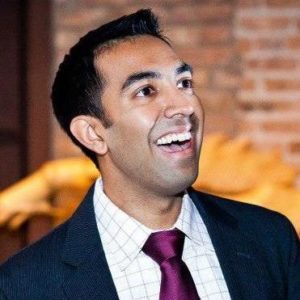
Harin Contractor (Courtesy: Twitter)
The Impact Project, a 501 C3 organization, is the research, education, and training arm. The work of Impact as a whole, is to provide education and training as well as to craft a winning message, build a campaign team, to build the backbone for races. And their focus is on U.S. issues – not foreign policy or bilateral relations with India as such, organizers clarified.
Resting on a not insignificant history of political awareness raising, Impact, and the host of existing organizations, are behind the growing effort to catapult Indian Americans to the “next level” of political engagement – among them, to name just a few — older organizations like WLP, IALI, South Asian Americans Leading Together; and the more recent ones – AAPIVictory Fund, NJLead, South Asian Registration Initiative, SARI; and even some in the making like Aseem Chipalkatti’s fledgling campaign consultancy effort in Seattle.
This Jan. 23, WLP tweeted, “Wow – we are overwhelmed by the record applications this year to #WLP2018 – there is so much energy in the community to get involved. We wish we had the ability to take more scholars. The pool is so tremendously talented this year. The future is bright for our community #Leaders
As the primaries proceed through the year, candidates like Maryland State Assembly member Aruna Miller, want Democrats to change — In Maryland, Aruna Miller, a State House representative is making a bid for Congress. She tweeted June 21 – “The race is an opportunity for Democrats to elect a woman to Maryland’s all-male congressional delegation.” #MD6 #ArunaforMD6,” she tweeted.
Impact, which launched its two branches Jan. 17, describes its leadership as made up of Indian-American philanthropists, community leaders, and political operatives and defines its mission as one that “builds Indian American political power by investing in leaders who catalyze change.” And the The Impact Fund, the PAC, “is a new initiative to help talented and patriotic Indian Americans run, win, and lead,” organizers say. The goals of Impact Project are to “convene Indian American leaders in policy, politics, and government; Recruit and train emerging leaders to run for office; Endorse viable candidates who reflect our values; Fund candidates early and often to build momentum and win.; and build power to fight back against regressive policies.”
While most of the organizers are Democrats, they told this correspondent the two organizations are distinct in their goals. “The IAIP (C3) cannot do any political work and that is a bright line we will never cross,” says Goyle.
“It gives us the flexibility to cover candidates at all levels,” Raghavan notes about having two distinct entities. At local levels candidates do not have to have a party affiliation. Half of the candidates Impact is tracking around the country, are not affiliated. “That’s how we build a bench of talent for public office and elected office.”
Meanwhile, the AAPI Victory Fund, which claims to be the “first of its kind SuperPAC,” was founded by Shekar Narasimhan, an entrepreneur who was appointed by President Obama as commissioner on his Advisory Commission on Asian Americans and Pacific Islanders. it rallies behind all Asian candidates.
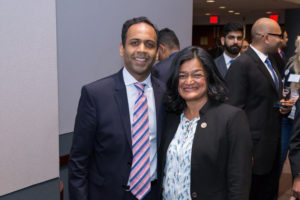
Impact Co-Founder Raj Goyle with Congresswoman Pramila Jayapal (Photo courtesy: IAIMPACT)
Our Time
The need for such organizations was felt years ago, and individuals have come forward to fill some of the gaps. “Other communities have this infrastructure. We have needed it for years,” says Raghavan.
But this is just the beginning. “Many aspects of the community are still untapped. A growth area for the organization (Impact) is to get out to other population areas such as Houston, Bay Area, Illinois etc.,” says Goyle.
“This is our time,” Raj, founder of the Raj Center on Indian Economic Policies at Columbia University, is quoted saying in a press release. “Across the country, a record number of Indian Americans are running for office. We can’t leave it to chance that they will win on their own. We owe them our support — and we have a plan to help them run, win, and lead,” he adds.
People like Contractor and Nisha Jain, both from WLP, and IALI which was very active from 2006-2010, could be considered the early building blocks for Impact, as would several other organizations which have worked over the last 15 years and more to raise awareness within the community.
As Contractor said, the strength of WLP lies in identifying these students early on, introducing them to mentors, and watching that mentorship work, long after the internships in Washington, D.C. He points to people like Federal Communications Commission Chairman Ajit Pai, or Neil Patel, who was an advisor to former Vice President Dick Cheney, and long-time conservative political activist Kapil Sharma, all Republicans, as well as Democrats like Barve, Sam Arora, former Maryland state delegate, and numerous others, who continue to keep contact with graduates of WLP.
“We were successful in placing people in both the Hillary Clinton and the Trump campaigns,” Contractor says. Graduates of WLP have gone on to win state level political office, such as Arora, and Niraj Antani, current Republican state representative in Ohio. Another graduate, Aakash Patel, a Republican, is running for the County Commission in Tampa, Florida.
“From WLP’s perspective, even if there is no formal organization, we see a new energy based on our applications alone,” contends Contractor. Another interesting development Contractor points to is that in more recent years, the pool of applicants and those selected has been “overwhelmingly” women.
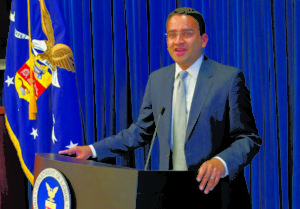
Gautam Raghavan
Puneet Ahluwalia, the 10th district representative on the Virginia Republican State Central Committee, who served on President Trump’s Asian Pacific Advisory Committee, told this writer, that at this time in the Indian-American Republican field, there are some individual efforts at supporting Republican candidates, but the efforts are “divisive” whereas, “Politics is about winning and bringing together.”
As for Impact, Ahluwalia sees it as meant mainly for Democrats. “The good news is we (Republicans) are planning something similar and robust,” he said, an organization that would be launched in the “next few months.” However, there were many Republican faces at the Impact Summit held in early June in Washington, D.C.
According to Ahluwalia, there is a “large pool” of talent in the Republican National Committee, waiting to help and guide candidates, something he hopes to tap for Indian-American candidates. He details his goals on his LinkedIn profile as follows – “elect Republicans at every level of office; promote free market, limited government, low tax & pro-business policies; and create greater opportunities for South Asians & minorities in the Party.”
Karthick Ramakrishnan, professor at University of California, Riverside, and founder of AAPIData, says Indian-Americans as an immigrant group, show key differences compared to other groups.
The traditional model among immigrant groups was to build political power at the local level – in cities and then move further. The Irish and the Italians did that, not so much the Greeks, Ramakrishnan notes — Italians in Boston, parts of New York City; the Irish also in Boston, Chicago, New York. Chinese-Americans in San Francisco, and parts of Los Angeles, especially the eastern parts of LA.
Indian-Americans are more spread out than even other Asian-American groups which tend to have heavy concentrations, like in California for instance. Where Indian Americans have a concentration, like in Silicon Valley, one sees the results — with Ro Khanna and Ami Bera in Congress.
“Indian-Americans are more spread out, tend to have higher incomes, higher education; and they also have greater civic engagement than other Asian groups,” but Ramakrishnan observes, “Indian-American engagement is not as strong as the Jewish group for instance.” A majority of Indian-Americans are still foreign born, he notes.
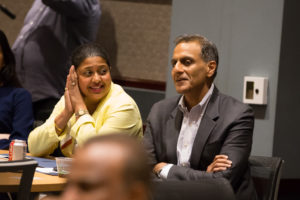
Impact Project Board Member Priya Dayananda with former Ambassador Rich Verma (Photo courtesy: IAIMPACT)
New Cohort
The Achilles heel of this minority, is the lack of a common agenda, he says, unlike the Jewish diaspora, for whom Israel is the point of reference. “All that said, we have a bumper crop in Congress, and more and more people running for office — Why? — because you have a much larger settled community which has lived here for decades; and you have a cohort of those born here,” Ramakrishna contends, and that is a significant base to build on. “These two groups are driving the growth/engagement/infrastructure building,” the difference now being the agenda – a focus on domestic rather than foreign policy toward India.
Several examples of this new cohort of leaders can be seen in New Jersey’s state and local elections last year, which put several Indian-Americans, most born and brought up in the U.S., to office – Vin Gopal as the first State Senate, Ravi Bhalla and Mayor of Hoboken, and the appointment of Gurbir Grewal as the first Indian-American State Attorney General. There are also already those who have served many years and are getting out due to term limits, like Michigan State Rep. Sam Singh, first Indian-American to get there, serving for many years and now ending his career as Minority leader because of term limits.
“9/11 triggered the rise in political engagement and changed the dynamic. It made a lot more people aware of how important it was to be involved in politics; that you could be a successful engineer or doctor and still be targeted,” Ramakrishnan notes.
Vin Gopal is a standing example of the type of Indian-American that the Indian-American PACs see so much potential in. Gopal grew up on a diet steeped in politics that his parents cultivated at home, and he told this correspondent that it was a given that he would gravitate to politics whichever field he went into. So when he opened a small business in Hazlet Township, he was immediately drawn to the fight against giving breaks to big business, and no ordinary big business, but Walmart. His rise from president of the Hazlet Township Business Association to chair of the Monmouth County Democratic Party, and on to candidate for State Senate in a hitherto Republican district is a story confirming that dictum – all politics is local.
Another difference today Ramakrishnan notes, is that political lines began to be drawn more forcefully within this community. “9/11 spurred political action, particularly of Democratic activists. Before that we had Indian-Americans giving to both parties.”
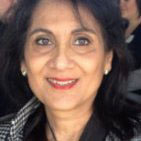
Ela Dutt | Editor, Parikh Worldwide Media
Leave Comments